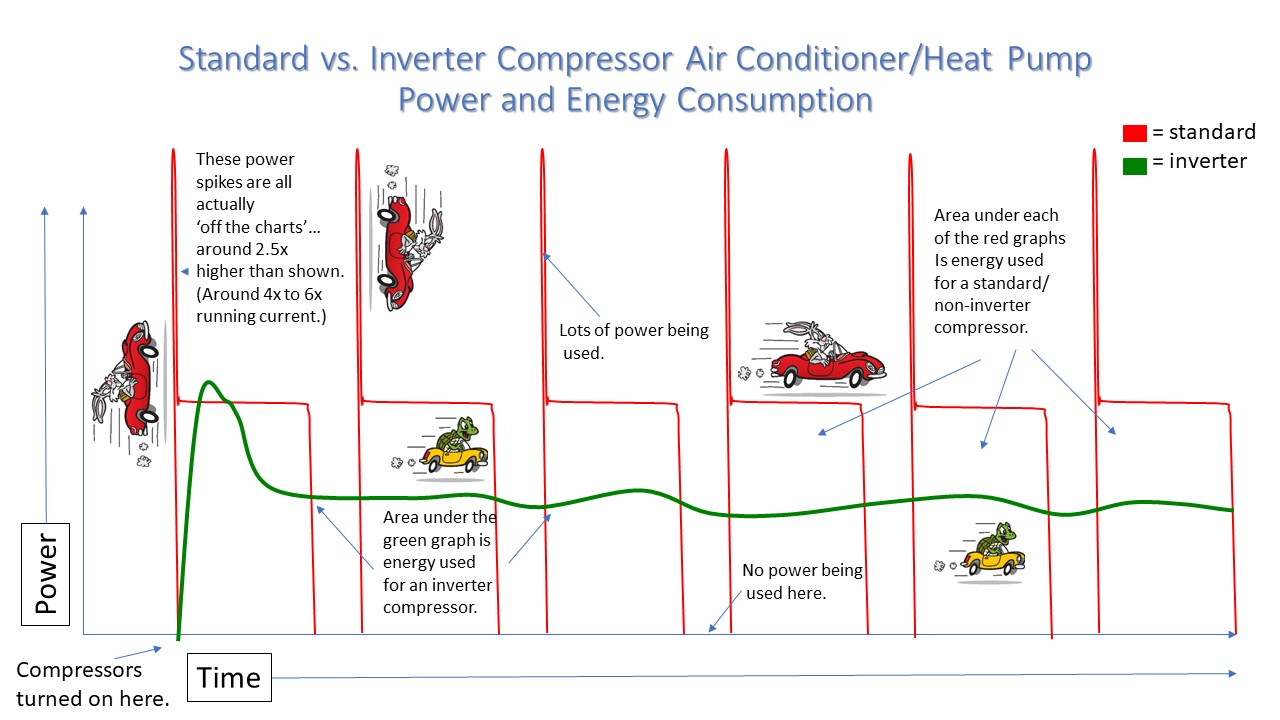See How Inverter Compressors Level the Power Roller Coaster for Energy Savings
It's a roller coaster out there without an inverter compressor in your air conditioner or heat pump. Old-style on/off only compressors, without speed control, are no friend to their owners when it comes to energy efficiency (a big deal these days when much of the country has seen double-digit electric utility increases in the last few months) or comfort. Inverter compressors, meanwhile, start slowly, avoiding the surge, or in-rush, current of their arcane predecessors. And, since they are capable of speeding up or slowing down to provide more or less refrigerant to cool or warm the space where they're installed, they help you avoid large temperature swings causing your target space to feel either too hot or too cold. Lots of folks have heard of these benefits, but let's take an up-close-and-personal inspection from the power, energy, and temperature curves over time to see how they're bestowed.
The terms power and energy are often thrown around as synonyms, but they're really a bit different. When it comes to electricity, power is snapshot of watts being used (technically work being done) at the moment, and energy is the accumulation of all of that power over time. For residential utility billing, this one's the important one. Utilities care about this bucket of watts we consume per hour, or, more precisely, the thousands of watts we consume per hour, where 1,000 watts consumed in an hour is known as a kilowatt-hour, or kWh. The average U.S. cost per kWh is now a $.168 (Feb. 2023), up from $.148 in Feb. 2022. And, this 13.5% increase is nothing compared to the increases some regions are enduring (we feel you, California). So, let's examine how we can use inverter compressors to help lower power (and thus energy) consumption for air conditioning and heating, which is often 75% of the summer or winter electricity used.
The graph below shows power used at startup, and then over a period of time of approximately 90 minutes. As long as both units are turned on and the thermostat setting stays where it is, and the outside conditions stay similar (i.e., in terms of time of day, cloud cover, outside air temperature), this stays about the same. In general, the further away the outside conditions vary from your setpoint, the more heating or cooling load you'll have, and more power (and energy) will be consumed, but directionally in line with what's shown here. Why are we focused on compressors? Because the fan motors, the other two main draws of power in a heat pump, normally consume less than 10% of the power that compressors use, and because units with inverter compressors will also use more-efficient condenser fans and blower motors, so, in effect, they're a rounding error to the analysis here.
Power and Energy
Note that. at startup, Standard compressors have an initial jolt of power needed to get going that inverter compressors don't have. This only lasts a few milliseconds, so that's why the standard compressor's power consumption looks like a chair. And it's not a 1-time chair. The standard compressor turns off completely every time it achieves a certain temperature 2 or 3 degrees past the setpoint, and then, if the unit is cycling twice an hour or so, in addition to the wear and tear on the system coming on and off that often, there's this continuous power requirement that's 4 to 6 times the normally running power every time the unit cycles on. These 'chairs,' in real life, have backs that are 2.5x higher than the ones shown here. We couldn't easily show this on the graph, since it would have shrunk down the bulk of the comparison area...so the backs are literally 'off the chart.' Inverter compressors, on the other hand, start very slowly, but they keep going. Depending on their configuration, they may actually have some additional capacity to cool your space faster when first started up. This takes a bit more power one time only, but you'll be comfortable faster. And the controls system for the inverter compressor doesn't have an on/off deadband cycle like the standard compressor. Instead, it shadows the actual air temperature, and its variable speed motor speeds up or slows down depending on the distance away from your set point.
The height of the red and green lines shows power, and, since the horizontal axis shows time, the area under the curve shows energy. Because of the startup power needed, and because this on/off cycle is repeated.

Temperature and Comfort
So, in addition to the inverter compressor's power and energy efficiency, which makes your wallet happy, you'll also be happy with the increased comfort afforded by the inverter compressor's ability to operate and deliver cooling or heating constantly, but at a slower speed, than the on/off standard compressor. The standard compressor sprints toward the setpoint, then passes this setpoint/finish line by a couple of degrees. The problem is that this jack rabbit is just sitting around, not working at all during this time, and the finish line is changed as the room's setpoint gets warmer again in cooling mode or colder again in warming mode. Then, it sprints back toward the finish line and the cycle repeats. Not efficient. And, not comfortable. You may by waiting for the unit to turn back on to feel cool again (in air conditioning mode), only to feel too cold right before the unit shuts off, since it exceeds your setpoint. The inverter compressor doesn't have this +/- 6 degree deadband. It works to hover around your setpoint which is both efficient and wonderfully comfortable.

Summary
The graph below maps power and energy on top of the fluctuation in temperature over time. In short, the standard compressor is a simpler machine, but it's not efficient for using energy or delivering comfort. The inverter compressor's electronics and controls are state-of-the-art and arcane. And yet, we get to enjoy the results.

